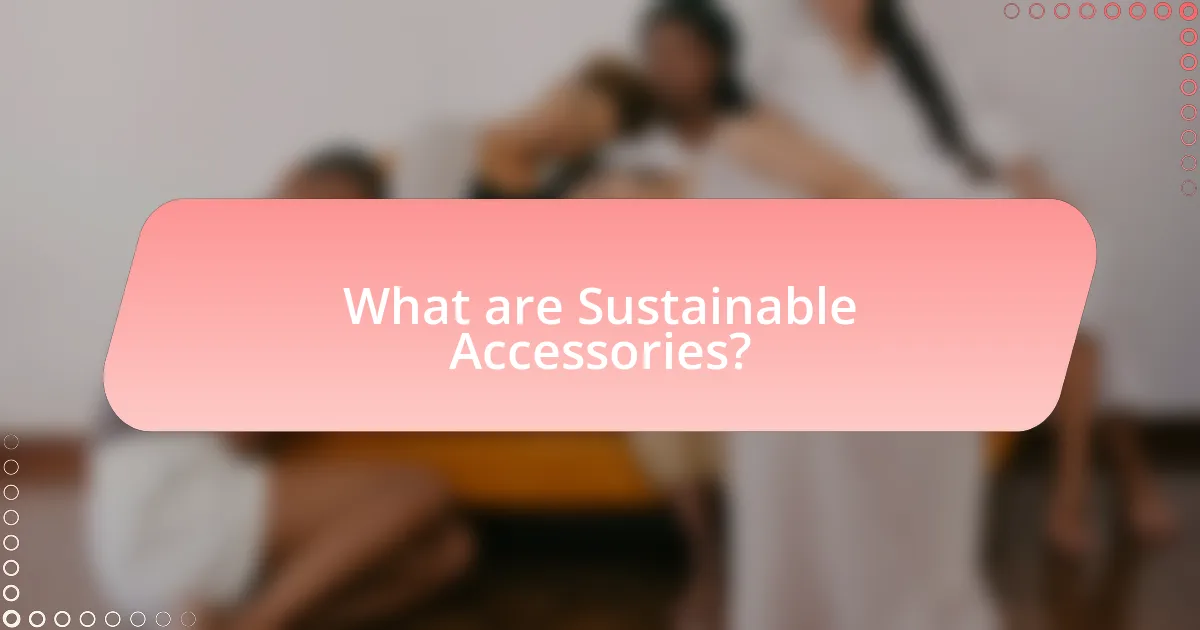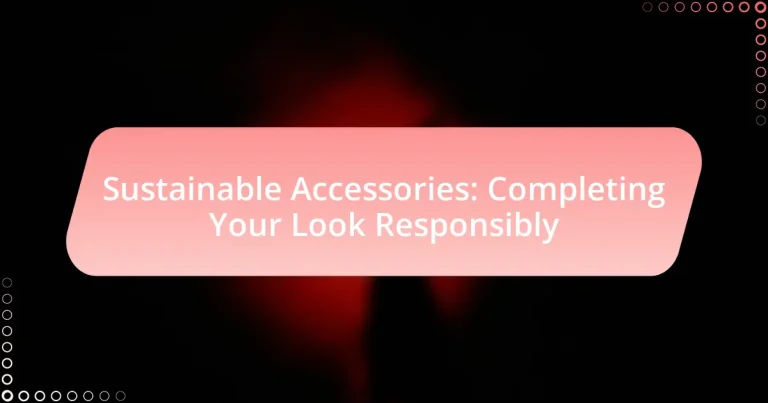Sustainable accessories are fashion items designed to enhance personal style while being produced in an environmentally friendly and socially responsible manner. This article explores the differences between sustainable and traditional accessories, highlighting the eco-friendly materials commonly used, such as organic cotton, recycled metals, and vegan leather. It discusses the positive environmental impact of sustainable production processes, the importance of ethical fashion practices, and the role of consumers in reducing waste. Additionally, the article provides insights on identifying eco-friendly jewelry, popular sustainable brands, and practical tips for incorporating sustainable accessories into one’s wardrobe.

What are Sustainable Accessories?
Sustainable accessories are items that enhance personal style while being produced in an environmentally friendly and socially responsible manner. These accessories often utilize materials that are renewable, recycled, or biodegradable, reducing their ecological footprint. For instance, brands may use organic cotton, reclaimed metals, or vegan leather, which minimizes harm to the planet and promotes ethical labor practices. The rise of sustainable fashion reflects a growing consumer demand for products that align with values of sustainability and ethical production, as evidenced by a 2021 survey indicating that 66% of global consumers are willing to pay more for sustainable brands.
How do Sustainable Accessories differ from traditional accessories?
Sustainable accessories differ from traditional accessories primarily in their materials and production processes. Sustainable accessories are made from eco-friendly materials such as organic cotton, recycled metals, and biodegradable plastics, whereas traditional accessories often utilize non-renewable resources and synthetic materials that contribute to environmental degradation. For instance, a study by the Ellen MacArthur Foundation highlights that the fashion industry is responsible for 92 million tons of waste annually, much of which comes from traditional accessory production methods. This stark contrast emphasizes the environmental benefits of sustainable accessories, which aim to reduce waste and promote ethical labor practices.
What materials are commonly used in Sustainable Accessories?
Sustainable accessories commonly utilize materials such as organic cotton, recycled polyester, bamboo, cork, and vegan leather. Organic cotton is grown without harmful pesticides, reducing environmental impact. Recycled polyester, made from post-consumer plastic bottles, diverts waste from landfills and conserves resources. Bamboo is a fast-growing plant that requires minimal water and no pesticides, making it an eco-friendly choice. Cork, harvested from the bark of cork oak trees, is renewable and biodegradable. Vegan leather, often made from materials like polyurethane or recycled plastics, offers an animal-friendly alternative to traditional leather. These materials collectively contribute to reducing the ecological footprint of fashion accessories.
How does the production process of Sustainable Accessories impact the environment?
The production process of Sustainable Accessories positively impacts the environment by reducing waste and utilizing eco-friendly materials. Sustainable accessories often incorporate recycled or organic materials, which minimizes the depletion of natural resources and lowers carbon emissions associated with traditional manufacturing. For instance, a study by the Ellen MacArthur Foundation highlights that using recycled materials can reduce greenhouse gas emissions by up to 70% compared to virgin materials. Additionally, sustainable production practices often emphasize ethical labor and lower water usage, further contributing to environmental conservation.
Why are Sustainable Accessories important for fashion consumers?
Sustainable accessories are important for fashion consumers because they promote environmental responsibility and ethical production practices. By choosing sustainable accessories, consumers contribute to reducing waste and pollution, as these products are often made from eco-friendly materials and produced with minimal environmental impact. For instance, a report by the Global Fashion Agenda indicates that the fashion industry is responsible for 10% of global carbon emissions, highlighting the need for sustainable alternatives. Additionally, sustainable accessories often support fair labor practices, ensuring that workers are treated ethically and compensated fairly. This alignment with consumer values enhances brand loyalty and encourages a shift towards more responsible consumption in the fashion industry.
What role do Sustainable Accessories play in reducing waste?
Sustainable accessories play a crucial role in reducing waste by promoting the use of eco-friendly materials and encouraging responsible consumption. These accessories, often made from recycled or biodegradable materials, help minimize the environmental impact associated with traditional accessory production, which frequently involves harmful practices and non-renewable resources. For instance, a study by the Ellen MacArthur Foundation highlights that the fashion industry generates over 92 million tons of waste annually, much of which can be mitigated through sustainable practices. By choosing sustainable accessories, consumers contribute to a circular economy, reducing landfill contributions and resource depletion.
How do Sustainable Accessories contribute to ethical fashion practices?
Sustainable accessories contribute to ethical fashion practices by promoting environmentally friendly materials and fair labor conditions. These accessories often utilize organic, recycled, or upcycled materials, reducing waste and resource consumption. For instance, brands like Stella McCartney prioritize sustainable sourcing, ensuring that their products have a lower carbon footprint. Additionally, many sustainable accessory brands adhere to fair trade principles, guaranteeing that artisans receive fair wages and work in safe conditions. This commitment to ethical production not only supports local economies but also fosters transparency in the supply chain, allowing consumers to make informed choices that align with their values.

What types of Sustainable Accessories are available?
Sustainable accessories include items such as bags made from recycled materials, jewelry crafted from ethically sourced metals and stones, and footwear produced using eco-friendly practices. These accessories are designed to minimize environmental impact while promoting ethical consumption. For instance, brands like Stella McCartney utilize vegan leather and recycled plastics in their products, demonstrating a commitment to sustainability. Additionally, accessories like biodegradable phone cases and organic cotton scarves further exemplify the range of sustainable options available in the market.
How can you identify eco-friendly jewelry?
Eco-friendly jewelry can be identified by checking for sustainable materials, ethical sourcing, and certifications. Look for pieces made from recycled metals, ethically sourced gemstones, or organic materials like wood or plant-based resins. Certifications from organizations such as the Responsible Jewelry Council or Fair Trade can also indicate that the jewelry meets environmental and ethical standards. Additionally, brands that provide transparency about their supply chain and production processes are more likely to offer eco-friendly options.
What certifications should you look for in sustainable jewelry?
Look for certifications such as Fair Trade, Responsible Jewelry Council (RJC), and the Kimberley Process in sustainable jewelry. Fair Trade certification ensures that artisans receive fair wages and work in safe conditions, promoting ethical labor practices. The Responsible Jewelry Council certification indicates adherence to responsible sourcing and environmental standards, ensuring that the jewelry is produced sustainably. The Kimberley Process aims to prevent the trade of conflict diamonds, ensuring that diamonds are sourced ethically and do not fund violence. These certifications provide assurance that the jewelry meets specific ethical and environmental standards.
Which brands are leading in sustainable jewelry production?
Brands leading in sustainable jewelry production include Brilliant Earth, Catbird, and Vrai. Brilliant Earth is known for its ethically sourced diamonds and recycled materials, with a commitment to transparency in its supply chain. Catbird focuses on handcrafted jewelry made from recycled gold and ethically sourced gemstones, emphasizing local production in Brooklyn. Vrai uses lab-grown diamonds and sustainable practices, ensuring minimal environmental impact. These brands exemplify the shift towards responsible sourcing and production in the jewelry industry.
What are the options for sustainable bags and purses?
Sustainable bags and purses include options made from organic cotton, recycled materials, hemp, and vegan leather. Organic cotton bags are produced without harmful pesticides, making them environmentally friendly. Recycled material bags, such as those made from repurposed plastic bottles, help reduce waste and promote recycling. Hemp is a durable and biodegradable fabric that requires less water and no pesticides to grow. Vegan leather, often made from plant-based materials, offers an animal-friendly alternative to traditional leather. These options collectively contribute to reducing environmental impact while providing stylish choices for consumers.
How do materials like recycled plastics and organic cotton enhance sustainability in bags?
Recycled plastics and organic cotton enhance sustainability in bags by reducing waste and minimizing environmental impact. Recycled plastics divert materials from landfills and oceans, decreasing pollution and conserving resources; for instance, using recycled PET can save up to 60% of energy compared to virgin plastic production. Organic cotton, grown without synthetic pesticides and fertilizers, promotes biodiversity and healthier ecosystems, while also using significantly less water—up to 91% less in some cases—compared to conventional cotton farming. Together, these materials contribute to a circular economy and lower carbon footprint, making bags more sustainable.
What are some popular brands offering sustainable bags?
Some popular brands offering sustainable bags include Patagonia, which uses recycled materials in its products, and Stella McCartney, known for its commitment to cruelty-free and eco-friendly practices. Other notable brands are Everlane, which emphasizes transparency in its supply chain, and Toms, recognized for its social impact initiatives. These brands are widely acknowledged for their efforts in sustainability and ethical production, making them leaders in the sustainable accessories market.

How can you incorporate Sustainable Accessories into your wardrobe?
To incorporate sustainable accessories into your wardrobe, prioritize items made from eco-friendly materials such as organic cotton, recycled metals, or sustainably sourced wood. Research shows that the fashion industry is responsible for 10% of global carbon emissions, making sustainable choices crucial for reducing environmental impact. By selecting accessories from brands that emphasize ethical production practices, you not only enhance your style but also contribute to a more sustainable future.
What are some tips for choosing Sustainable Accessories?
To choose sustainable accessories, prioritize items made from eco-friendly materials such as organic cotton, recycled metals, or sustainably sourced wood. These materials reduce environmental impact and promote responsible production practices. Additionally, consider brands that emphasize ethical labor practices and transparency in their supply chains, as this ensures fair treatment of workers and supports local economies. Researching certifications like Fair Trade or Global Organic Textile Standard can further guide your choices, as these labels indicate adherence to sustainability standards.
How can you assess the sustainability of a brand before purchasing?
To assess the sustainability of a brand before purchasing, examine the brand’s transparency regarding its supply chain, materials, and production processes. Brands that prioritize sustainability often provide detailed information about their sourcing practices, such as using organic or recycled materials, and their commitment to ethical labor practices. For instance, a study by the Fashion Institute of Technology found that 66% of consumers are willing to pay more for sustainable brands, indicating a market trend towards transparency and ethical practices. Additionally, certifications from recognized organizations, such as Fair Trade or Global Organic Textile Standard, can serve as proof of a brand’s commitment to sustainability.
What are some common misconceptions about Sustainable Accessories?
Common misconceptions about sustainable accessories include the belief that they are always more expensive, less stylish, and less durable than conventional options. Many consumers assume that sustainable accessories, due to their eco-friendly materials and ethical production processes, come with a higher price tag; however, studies show that prices can be comparable when considering the long-term value and reduced environmental impact. Additionally, the notion that sustainable accessories lack style is inaccurate, as numerous brands now offer trendy designs that appeal to a wide audience, proving that sustainability and fashion can coexist. Lastly, the idea that these accessories are less durable is misleading; many sustainable materials, such as organic cotton and recycled plastics, are engineered for longevity, often outperforming traditional materials in terms of wear and tear.
How can you maintain and care for your Sustainable Accessories?
To maintain and care for your sustainable accessories, regularly clean them according to the material specifications, such as using mild soap and water for fabric items or a soft cloth for metal components. Proper storage is essential; keep accessories in a cool, dry place to prevent damage from moisture or direct sunlight. Additionally, avoid exposing them to harsh chemicals or extreme temperatures, as these can degrade the materials over time. Following these care practices can extend the lifespan of sustainable accessories, ensuring they remain functional and visually appealing.
What cleaning methods are safe for eco-friendly materials?
Safe cleaning methods for eco-friendly materials include using natural ingredients like vinegar, baking soda, and lemon juice. These substances effectively clean without introducing harmful chemicals, making them suitable for materials such as organic cotton, bamboo, and recycled fabrics. For instance, vinegar acts as a disinfectant and deodorizer, while baking soda serves as a gentle abrasive that can remove stains without damaging the material. Studies have shown that these natural cleaners can reduce environmental impact compared to conventional cleaning products, which often contain toxic substances.
How can proper care extend the life of your Sustainable Accessories?
Proper care can significantly extend the life of your sustainable accessories by preventing wear and tear, maintaining their functionality, and preserving their aesthetic appeal. Regular cleaning, appropriate storage, and avoiding exposure to harsh chemicals or extreme conditions help sustain the materials used in these accessories, which are often eco-friendly and sensitive to damage. For instance, natural fibers like organic cotton or hemp can degrade faster if not cared for properly, while metals can tarnish without proper maintenance. By following manufacturer care instructions and using gentle cleaning methods, you can ensure that your sustainable accessories remain in good condition for a longer period, thus reducing the need for replacements and supporting sustainability efforts.
What are practical ways to support sustainable fashion?
Practical ways to support sustainable fashion include purchasing from eco-friendly brands, opting for second-hand clothing, and practicing mindful consumption. Eco-friendly brands often use sustainable materials and ethical labor practices, which contribute to reducing environmental impact. For instance, brands like Patagonia and Reformation prioritize sustainability in their production processes. Buying second-hand clothing extends the life cycle of garments and reduces waste, with platforms like ThredUp and Poshmark facilitating this practice. Mindful consumption involves evaluating the necessity of purchases and choosing quality over quantity, which can significantly decrease the demand for fast fashion. According to a report by the Ellen MacArthur Foundation, shifting towards a circular economy in fashion could reduce global carbon emissions by 44% by 2030.


